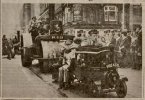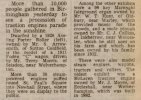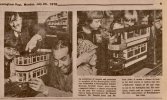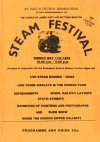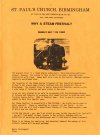-
Welcome to this forum . We are a worldwide group with a common interest in Birmingham and its history. While here, please follow a few simple rules. We ask that you respect other members, thank those who have helped you and please keep your contributions on-topic with the thread.
We do hope you enjoy your visit. BHF Admin Team -
HI folks the server that hosts the site completely died including the Hdd's and backups.
Luckily i create an offsite backup once a week! this has now been restored so we have lost a few days posts.
im still fixing things at the moment so bear with me and im still working on all images 90% are fine the others im working on now
we are now using a backup solution
You are using an out of date browser. It may not display this or other websites correctly.
You should upgrade or use an alternative browser.
You should upgrade or use an alternative browser.
Science Museum Newhall Street
- Thread starter ASTONITE
- Start date
Moby the Villan
proper brummie kid
Loved the steam traction engine parade along here. One machine had a siren so loud it set off the burglar alarms outside the Post Office!
Radiorails
master brummie
Rotherham had some single entrance trams and Blackpool had many centre entrance ones. Don;t recall the seating arrangements however.
Lady Penelope
master brummie
Wonderful pictures Mark. The 78 was my tram and if it had still been there when I worked in Aston I wouldn't have spent ages waiting for a 65 bus at Streetly Road terminus. I was invariably late for work despite getting to the stop a long time before I should have needed to.
I loved going to see the tram in the museum and can remember the feel of the rather scratchy 'velvet' on the seats and the smell of the wooden floor etc.
I loved going to see the tram in the museum and can remember the feel of the rather scratchy 'velvet' on the seats and the smell of the wooden floor etc.
Last edited:
Radiorails
master brummie
In the times before prolific car ownership you did not have to wait for long for a tram. If you just missed one then another would be along in a minute or two. They did have a certain degree of style, not the plastic or metal of modern vehicles.
Spent many hours at Science Museum Newhall st, I loved the steam rallies they had outside every year , inside all the machines would be working as well , fantastic memories.
If I can manage it I will post some photos of steam rallies there over the years, not that hot on posting pics so no promises.
And the Watt pumping engine , magical site to see it working , pity the youngsters now that only know about Xbox and PS games what they have missed a wonderment of real worldly thing's.
If I can manage it I will post some photos of steam rallies there over the years, not that hot on posting pics so no promises.
And the Watt pumping engine , magical site to see it working , pity the youngsters now that only know about Xbox and PS games what they have missed a wonderment of real worldly thing's.
The number 11 bus was like a banana always came in bunches.In the times before prolific car ownership you did not have to wait for long for a tram. If you just missed one then another would be along in a minute or two. They did have a certain degree of style, not the plastic or metal of modern vehicles.
mw0njm.
A Brummie Dude
who invented the steam engine... and when?
Here's a brief history of steam power:- 1st century CE: Hero of Alexandria demonstrates a steam-powered spinning sphere called an aeolipile.
- 16th century CE: Italian architect Giovanni Branca (1571–1640) uses a steam jet to rotate the blades of a small wheel, anticipating the steam turbine developed by Sir Charles Parsons in 1884.
- 1680: Dutch physicist Christiaan Huygens (1629–1693) makes the first piston engine using a simple cylinder and piston powered by exploding gunpowder. Huygens' assistant Denis Papin (1648–c.1712) realizes steam is a better way to drive a cylinder and piston.
- 1698: Thomas Savery (c.1650–1715) develops a steam-powered water pump called the Miner's Friend. It's a simple reciprocating steam engine (or beam engine) for pumping water from mines.
- 1712: Englishman Thomas Newcomen (1663–1729) develops a much better design of steam-powered, water-pumping engine than Savery and is usually credited with inventing the steam engine. A Scottish engineer named James Watt (1736–1819) figures out a much more efficient way of making power from steam after improving a model of the Newcomen engine. Watt's improvements of Newcomen's engine lead to the widespread adoption of steam.
- 1770: French army officer Nicolas-Joseph Cugnot (1725–1804) invents a steam-powered, three-wheeled tractor.
- 1797: English mining engineer Richard Trevithick (1771–1833) develops a high-pressure steam version of Watt's engine, paving the way for steam locomotives.
- 1803: English engineer Arthur Woolf (1776–1837) makes a steam engine with more than one cylinder.
- 1804: American industrialist Oliver Evans (1775–1819) invents a steam-powered passenger vehicle. Like Trevithick, he recognizes the importance of high-pressure steam and builds more than 50 steam-powered vehicles.
- 1807: American engineer Robert Fulton (1765–1815) runs the first steamboat service along the Hudson River.
- 1819: Steam-powered ocean ship Savannah crosses the Atlantic from New York to Liverpool in only 27 days.
- 1825: English engineer George Stephenson (1781–1848) builds the world's first steam railway between the towns of Stockton and Darlington. To begin with, steam locomotives pull only heavy coal trucks, while passengers are ferried in horse-drawn carriages.
- 1830: The Liverpool and Manchester Railway becomes the first to use steam power for hauling both passengers and freight.
- 1882: The prolific American inventor Thomas Edison (1847–1931) opens the world's first commercial power plant at Pearl Street, New York. It uses high-speed steam engines to power the electricity generators.
- 1884: English engineer Sir Charles Parsons (1854–1931) develops the steam turbine for his high-speed steam boat T
Brummie a long time ago
master brummie
On the subject of steam, the Dorset steam fair is back again this year, 25 to 29 August.
I loved the Birmingham Science Museum. I can still see the demo telephone exchange working in my mind’s eye. When I was old enough to go into town on my own, that was number one destination.
Andrew.
I loved the Birmingham Science Museum. I can still see the demo telephone exchange working in my mind’s eye. When I was old enough to go into town on my own, that was number one destination.
Andrew.
SteveBhx
master brummie
I always though it was not who but Watt that invented the steam enginewho invented the steam engine... and when?
Here's a brief history of steam power:
- 1st century CE: Hero of Alexandria demonstrates a steam-powered spinning sphere called an aeolipile.
- 16th century CE: Italian architect Giovanni Branca (1571–1640) uses a steam jet to rotate the blades of a small wheel, anticipating the steam turbine developed by Sir Charles Parsons in 1884.
- 1680: Dutch physicist Christiaan Huygens (1629–1693) makes the first piston engine using a simple cylinder and piston powered by exploding gunpowder. Huygens' assistant Denis Papin (1648–c.1712) realizes steam is a better way to drive a cylinder and piston.
- 1698: Thomas Savery (c.1650–1715) develops a steam-powered water pump called the Miner's Friend. It's a simple reciprocating steam engine (or beam engine) for pumping water from mines.
- 1712: Englishman Thomas Newcomen (1663–1729) develops a much better design of steam-powered, water-pumping engine than Savery and is usually credited with inventing the steam engine. A Scottish engineer named James Watt (1736–1819) figures out a much more efficient way of making power from steam after improving a model of the Newcomen engine. Watt's improvements of Newcomen's engine lead to the widespread adoption of steam.
- 1770: French army officer Nicolas-Joseph Cugnot (1725–1804) invents a steam-powered, three-wheeled tractor.
- 1797: English mining engineer Richard Trevithick (1771–1833) develops a high-pressure steam version of Watt's engine, paving the way for steam locomotives.
- 1803: English engineer Arthur Woolf (1776–1837) makes a steam engine with more than one cylinder.
- 1804: American industrialist Oliver Evans (1775–1819) invents a steam-powered passenger vehicle. Like Trevithick, he recognizes the importance of high-pressure steam and builds more than 50 steam-powered vehicles.
- 1807: American engineer Robert Fulton (1765–1815) runs the first steamboat service along the Hudson River.
- 1819: Steam-powered ocean ship Savannah crosses the Atlantic from New York to Liverpool in only 27 days.
- 1825: English engineer George Stephenson (1781–1848) builds the world's first steam railway between the towns of Stockton and Darlington. To begin with, steam locomotives pull only heavy coal trucks, while passengers are ferried in horse-drawn carriages.
- 1830: The Liverpool and Manchester Railway becomes the first to use steam power for hauling both passengers and freight.
- 1882: The prolific American inventor Thomas Edison (1847–1931) opens the world's first commercial power plant at Pearl Street, New York. It uses high-speed steam engines to power the electricity generators.
- 1884: English engineer Sir Charles Parsons (1854–1931) develops the steam turbine for his high-speed steam boat T
Chunky AC
master brummie
Same here, The telephone exchange and the Fox and goose game. I also loved the cut away Merlin Engine, i used to stand and wonder how it was designed and made. A beautiful functional sculpture of metal. I cannot understand how Birmingham can spend hundreds of millions pounds on the Commonwealth games, and not have a dedicated musem to Science and industry. Alf.COn the subject of steam, the Dorset steam fair is back again this year, 25 to 29 August.
I loved the Birmingham Science Museum. I can still see the demo telephone exchange working in my mind’s eye. When I was old enough to go into town on my own, that was number one destination.
Andrew.
izzy eckerslike
master brummie
some bits and pieces ended up at the Millennium point Think tank where you pay £14 to look at them, I was fascinated by the collection of guns in the original museum and made a working replica of a 17th century wheelock pistol I saw there but they have all disappeared along with everything else. Probably stored in the proof house with limited access by appointment only.Same here, The telephone exchange and the Fox and goose game. I also loved the cut away Merlin Engine, i used to stand and wonder how it was designed and made. A beautiful functional sculpture of metal. I cannot understand how Birmingham can spend hundreds of millions pounds on the Commonwealth games, and not have a dedicated musem to Science and industry. Alf.C
There are some warehouses in Dollman street Birmingham, "The Museums collection centre" stacked floor to ceiling with 800,000 old ex museum exhibits inc lots of vehicles, they open a few of days a year to let the public in free of charge, we went one time but it's not quite the same and a lot of stuff on the higher shelves would need a forklift to get up high,
Last edited:
Mark Tooze
master brummie
If you want to see some of the rest of the old Science Museum exhibits, go to the open day at the Museums Collection Centre in Dolmann St on September 17th - its free but this year prior booking is required - website is (at 24/08/22 09.55) currently being swapped over to a new one, but should be online later today.
Here are a few photos from the last (pre-covid) one in 2019:-

Here is the telephone exchange mentioned earlier (I think I also spent a large part of my childhood playing on this....):-


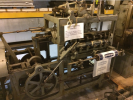
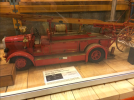
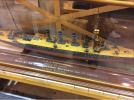
Hopefully they will have the vintage bus service running this year as well:-

Here are a few photos from the last (pre-covid) one in 2019:-

Here is the telephone exchange mentioned earlier (I think I also spent a large part of my childhood playing on this....):-





Hopefully they will have the vintage bus service running this year as well:-

Brummie a long time ago
master brummie
I can hear it now. Thanks.Here is the telephone exchange mentioned earlier (I think I also spent a large part of my childhood playing on this....):-
Did it have the old black telephones back in the day ?
Andrew.
mw0njm.
A Brummie Dude
James Watt did not invent the steam engine. He did, however, improve the engine apparatus. In 1764 Watt observed a flaw in the Newcomen steam engine: it wasted a lot of steam. Watt deduced that the waste resulted from the steam engine’s single-cylinder design. In 1765 Watt conceived of a separate condenser—a device to reduce the amount of waste produced by the Newcomen steam engine. Watt patented the device in 1769. In 1776 Watt and his business partner, Matthew Boulton, installed two steam engines with separate condensers. The modified steam engines not only reduced waste but also cut fuel costs. Watt spent the next several years improving his design, adding to it the “sun-and-planet” gear (1781), the double-acting engine (1782), the parallel motion (1784), a flywheel (1788), and a pressure gauge (1790).
mw0njm.
A Brummie Dude
i loved to hear the relays chatter when you dialed a numberOn the subject of steam, the Dorset steam fair is back again this year, 25 to 29 August.
I loved the Birmingham Science Museum. I can still see the demo telephone exchange working in my mind’s eye. When I was old enough to go into town on my own, that was number one destination
RobT
Acemeccanoman
Seen in a August 1953 Meccano Magazine, this Aveling Porter Single Cylinder Steam Roller made in 1862, was found some years ago on the roadside near Lichfield.
It is seen here driven by Mr T.G.Hunt to it's final resting place at the New Science & Industry Museum, travelling along City Road, which it originally helped to lay.

It is seen here driven by Mr T.G.Hunt to it's final resting place at the New Science & Industry Museum, travelling along City Road, which it originally helped to lay.

RobT
Acemeccanoman
There's 23 photos of the road roller AB9331 hereSeen in a August 1953 Meccano Magazine, this Aveling Porter Single Cylinder Steam Roller made in 1862, was found some years ago on the roadside near Lichfield.
It is seen here driven by Mr T.G.Hunt to it's final resting place at the New Science & Industry Museum, travelling along City Road, which it originally helped to lay.
View attachment 179526
Birmingham Museum Collection 2012, pictures of Aveling & Porter Road Roller 2992 - Steam Scenes
Pictures of Aveling & Porter Road Roller 2992 which were present at Birmingham Museum Collection 2012
Stokkie
master brummie
Avoncroft museum near Bromsgrove has a working demo exchange and informative ex-BT engineers who can explain the process.i loved to hear the relays chatter when you dialed a number
Richard Dye
master brummie
Amazing how reliable that system was considering the number of moving parts!Both Avoncroft and that little telephone exchange are very interesting. I popped in last year and had a chat to the guy looking after it.
View attachment 179530
Janet Hunt
master brummie
I used to love the Traction engines rally in Newhall Street, seen it every year in the 60's and early 70's.
Found these 2 pictures of the 46235 City of Birmingham originally the 6235. This Train used to be in the science museum and is now at the Think Tank. I remember it used to move a short distance on the tracks in the science museum at sheduled times. I am guessing the train was being sited in The science museum in the first photo and relocated to The Think Tank in the Third Photo.
A little history attached in the link. https://preservedbritishsteamlocomotives.com/46235-city-of-birmingham-lms-6235-br-46235/
Found these 2 pictures of the 46235 City of Birmingham originally the 6235. This Train used to be in the science museum and is now at the Think Tank. I remember it used to move a short distance on the tracks in the science museum at sheduled times. I am guessing the train was being sited in The science museum in the first photo and relocated to The Think Tank in the Third Photo.
A little history attached in the link. https://preservedbritishsteamlocomotives.com/46235-city-of-birmingham-lms-6235-br-46235/
Attachments
-
 09ad69223292f59f9a244c96f365597a.jpg145.6 KB · Views: 17
09ad69223292f59f9a244c96f365597a.jpg145.6 KB · Views: 17 -
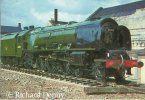 46235-City-of-Birmingham-outside-the-museum-at-Birmingham-before-being-built-around.-May-1966.jpg882.2 KB · Views: 18
46235-City-of-Birmingham-outside-the-museum-at-Birmingham-before-being-built-around.-May-1966.jpg882.2 KB · Views: 18 -
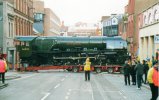 2926839_7e403f7b.jpg95.2 KB · Views: 18
2926839_7e403f7b.jpg95.2 KB · Views: 18 -
 46235-City-of-Birmingham-at-Stafford-.jpg409.3 KB · Views: 19
46235-City-of-Birmingham-at-Stafford-.jpg409.3 KB · Views: 19 -
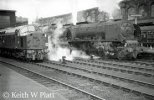 46235.jpg9.4 KB · Views: 17
46235.jpg9.4 KB · Views: 17
Last edited:
Richard Dye
master brummie
Something romantic about steam locos! I know things have to change but it never hurts to dream a little!I used to love the Traction engines rally in Newhall Street, seen it every year in the 60's and early 70's.
Found these 2 pictures of the 46235 City of Birmingham originally the 6235. This Train used to be in the science museum and is now at the Think Tank. I remember it used to move a short distance on the tracks in the science museum at sheduled times. I am guessing the train was being sited in The science museum in the first photo and relocated to The Think Tank in the Third Photo.
A little history attached in the link. https://preservedbritishsteamlocomotives.com/46235-city-of-birmingham-lms-6235-br-46235/
Janet Hunt
master brummie
I absolutely agree Richard, nostalgia is a beautiful thing!Something romantic about steam locos! I know things have to change but it never hurts to dream a little!
Victorian Extravaganza
knowlegable brummie

Science Museum traction engine rally, May 1975 early in the morning.
Victorian Extravaganza
knowlegable brummie

May 1975 rally.

